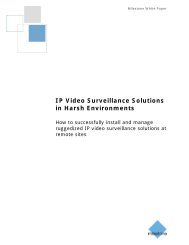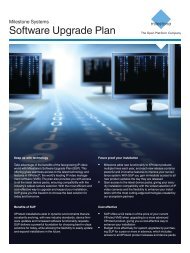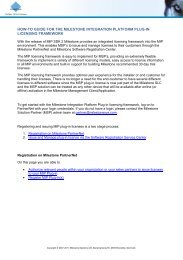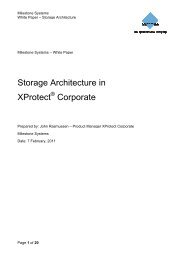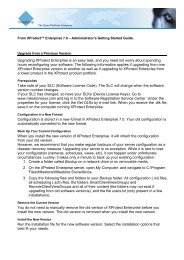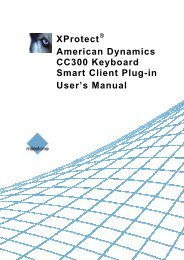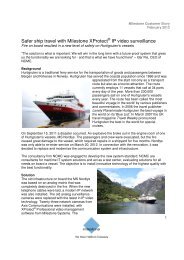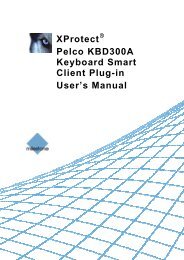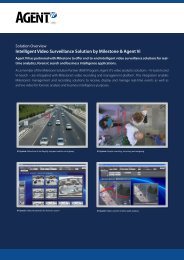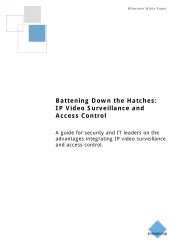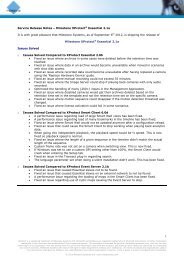XProtect Express 1.1; Administrator's Manual - Milestone
XProtect Express 1.1; Administrator's Manual - Milestone
XProtect Express 1.1; Administrator's Manual - Milestone
You also want an ePaper? Increase the reach of your titles
YUMPU automatically turns print PDFs into web optimized ePapers that Google loves.
<strong>Milestone</strong> <strong>XProtect</strong> ® <strong>Express</strong> <strong>1.1</strong><strong>Administrator's</strong> <strong>Manual</strong>NameRecording PathArchiving PathTotal SizeFree SpaceDynamic path selection forarchivesArchiving TimesDescriptionPath to the folder in which the camera's database should be stored. Defaultis C:\MediaDatabase. To browse for another folder, click the browse iconnext to the required cell. You can only specify a path to a folder on a localdrive. You cannot specify a path to a network drive. If you use a networkdrive, it is not be possible to save recordings if the network drive becomesunavailable.If you change the recording path, and you have existing recordings at theold location, you are asked whether you want to move the recordings to thenew location (recommended), leave them at the old location, or deletethem.Tip: If you have several cameras, and several local drives are available,you can improve performance by distributing individual cameras' databasesacross several drives.Only editable if not using dynamic paths for archiving (see "Aboutarchiving" on page 118). Path to the folder in which the camera's archivedrecordings should be stored. Default is C:\MediaDatabase.To browse for another folder, click the browse icon next to the required cell.You can specify a path to a local or network drive. If you change thearchiving path, and there are existing archived recordings at the oldlocation, you will be asked whether you want to move the archivedrecordings to the new location (recommended), leave them at the oldlocation, or delete them. Note that if you move archived recordings,<strong>XProtect</strong> <strong>Express</strong> will also archive what is currently in the cameradatabase. In case you wonder why the camera database is empty just afteryou have moved archived recordings, this is the reason.Total size of the drive.Amount of unused space left on the drive.If using this option (highly recommended), you should select a number ofdifferent local drives for archiving. If the path containing the <strong>XProtect</strong><strong>Express</strong> database is on one of the drives you have selected for archiving,<strong>XProtect</strong> <strong>Express</strong> will always try to archive to that drive first. If not, <strong>XProtect</strong><strong>Express</strong> automatically archives to the archiving drive with the mostavailable space at any time, provided there is not a camera database usingthat drive. Which drive has the most available space may change duringthe archiving process, and archiving may therefore happen to severalarchiving drives during the same process. This fact will have no impact onhow users find and view archived recordings.Specify when you want <strong>XProtect</strong> <strong>Express</strong> to automatically move recordingsto your archiving path(s). You can specify up to 24 archiving times per day,with minimum one hour between each one. Select the hour, minute andsecond values and click the up and down buttons to increase or decreasevalues, or simply overwrite the selected value, and then click Add.The more you expect to record, the more often you should archive.Recording and archiving settingsSelect recording and archiving (see "About archiving" on page 118) paths for each individual camera.All properties on a white background are editable, properties on a light blue background cannot be edited.www.milestonesys.com 63 Wizards



